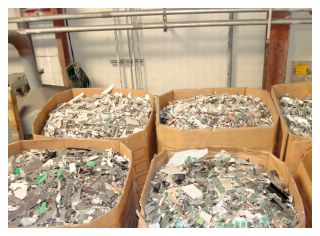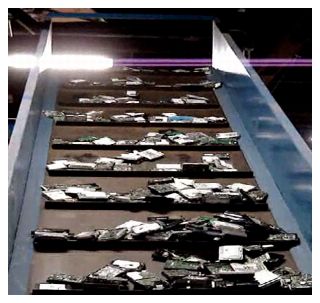The term “eWaste” is broadly defined as obsolete, surplus, or broken electrical or electronic devices, but may include a variety of equipment (see the Recyclable Postal Service eWaste list). Improper disposal of eWaste could be harmful to human health and the environment as it generally contains heavy metals such as lead, cadmium, and mercury. Exporting eWaste has resulted in “third world” dumping, which poses serious environmental and public health threats.1 eWaste also puts confidential or proprietary information at risk.2 Therefore, the USPS® has developed policies for managing eWaste: 1) secure data destruction, 2) recycling and reuse, and 3) landfill avoidance.

According to recent EPA studies, 2009 sales of new consumer electronics in the United States doubled over the previous 10-year period. In that same year:
n 438 million consumer electronics were sold.
n 5 million tons of electronics were placed in storage.
n 2.37 million tons were ready for end-of-life management.
n Only 25 percent of this tonnage was collected for recycling.
Until we can maximize reuse and recycling of this equipment, eWaste will continue to pose serious environmental challenges.

The USPS continues to upgrade its information technology platform and faces the concurrent challenge of disposing of excess equipment caused by the realignment, consolidation, and downsizing of its network. As a result, the USPS generation of eWaste will substantially increase over the next several years. In 2011, USPS Supply Management entered into an innovative revenue sharing contract with Asset LifeCycle, LLC, at the Topeka Material Distribution Center, to promote the collection, reuse, recycling, and disposal of electronic equipment.
Asset LifeCycle is a third party certified “responsible recycler.” This certification ensures best management practices and guarantees that the vendor assesses the environmental, worker health, and security practices of entities managing used electronics generated by the Postal Service. In 2012, the Postal Service recycled over 1,267 tons of eWaste and generated over $740,000 in revenue for the Postal Service. In contrast, the Postal Service recycled 721 tons and earned $345,000 in 2011. For FY 2013, this innovative recycling program is expected to once again double the USPS recycled eWaste tonnage and revenue. It pays to recycle eWaste within the Postal Service.
n ACE Hardware and Equipment. Contact your local IT office to get accountability, collection, and shipping procedures for shipping ACE hardware and equipment to the Topeka Material Distribution Center.
n Processing and Distributions Centers. Follow MMO 04212, which provides instructions for shipping eWaste to the Topeka Material Distribution Center. Click the link for instructions: http://blue.usps.gov/sustainability/electronic_stewardship.htm.
n Post Offices. Contact your local IT office for ACE-related hardware and equipment. Other eWastes (see the Recyclable Postal Service eWaste list) may be shipped directly to the Topeka Material Distribution Center.
n Electronic Security-Related Equipment. Contact your local Postal Inspection Service Field Office.
Make sure your office is recycling its eWaste to ensure these items are generating revenue, rather than being placed in the trash. To take advantage of this nationwide eWaste recycling program, go to the sustainability website and download the instructions for sending your obsolete or non-functioning equipment to the Topeka Material Distribution Center. The eWaste shipping instructions are available at: http://blue.usps.gov/sustainability/ electronic_stewardship.htm.
For more information on this program, contact the Office of Sustainability via email at Sustainability@usps.gov.
n Desktop computer, laptop computer, docking stations, and related power cords.
n CRT & LCD monitors.
n CD players, DVD players, optical drives, and modems.
n Circuit boards, PC boards, CPU, integrated chips, and finger cards.
n Cisco equipment.
n Tape backup equipment and data types.
n Calculators and electric typewriters.
n Point of sale equipment (POS).
n Hard drives, keyboards, and mice.
n Copiers, printers, plotters, and faxes.
n Network equipment, surge protectors, and wires and cables.
n Printer supplies (toner and ink).
n Overhead projectors.
n Fax machines and scanners.
n Cell phones, chargers, and wireless devices.
n Car chargers.
n Telephones, pagers, answering machines, adapters, and cords.
n Global positioning systems (GPS), cords, and chargers.
n Personal digital assistants (PDAs).
n Televisions, VCRs, DVD players, and speakers.
n Labeling and laminating machines.
n Cameras, camcorders, video and sound equipment, adapters, and cables.
n Microwaves and small electrical appliances.
n Power tools.
n Electric motors and fans.
n Switches.
n Universal power supply.
n Test equipment (voltage meters and field instruments).
n Uninterruptible power supplies (UPS).
n Digital signs and sign board readers.
n Whitebox systems.
